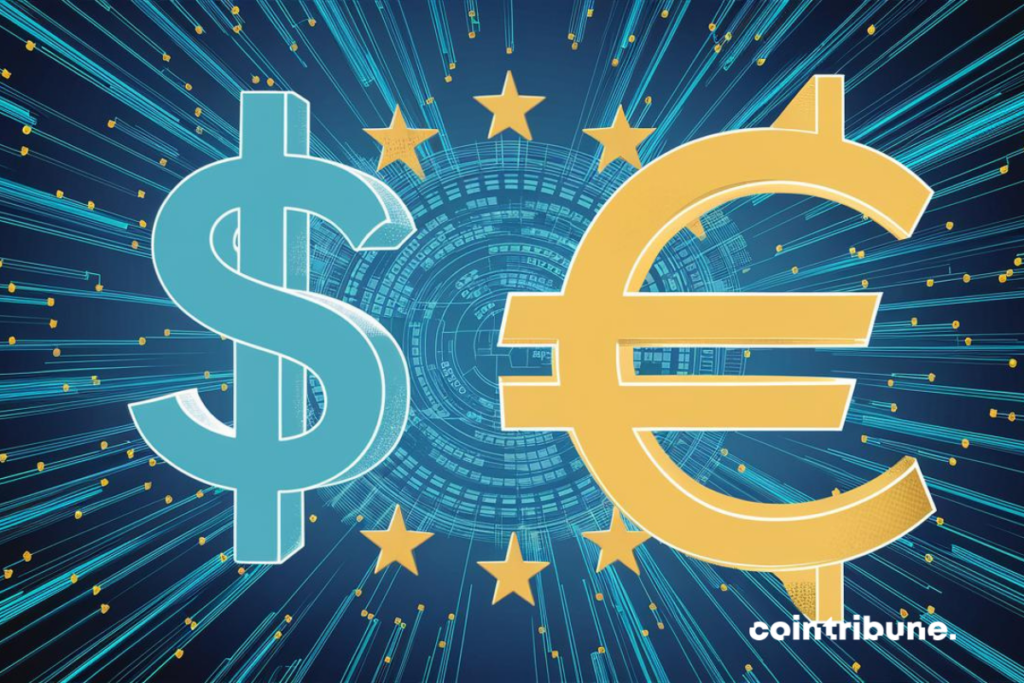Mountain lion? pic.twitter.com/Ww5nvFAJlh
— Crypto.com (@cryptocom) July 10, 2024
A
A
MiCA - Truth & Lies
Mon 15 Jul 2024 ▪
5
min read ▪ by
Getting informed
▪
Regulation Crypto
Summarize this article with:
The entry into force of MiCA in June is making waves. Concerns are palpable regarding the introduced limits on stablecoins.

Stablecoin and monetary sovereignty
The European regulation MiCA concerning stablecoins introduces limits beyond which the issuance of foreign stablecoins must cease.
The limits only target stablecoins backed by the dollar, other foreign currencies, or a basket of assets including multiple currencies, commodities, cryptocurrencies, or other assets. Facebook’s defunct Libra/Diem project is a good example.
The issuer of a foreign stablecoin that becomes too important in everyday payments (transactions to pay for goods and services) will have to cease issuance if the limit of 200 million euros per day is exceeded. The EU specifies that only stablecoins backed by the euro can be used to pay for goods and services like your groceries or rent.
However, there are no limits concerning the conversion between stablecoins and cryptocurrencies, especially on DEX (Decentralized exchange). Nothing changes for those using stablecoins to buy bitcoins. And it does not matter whether they are stablecoins backed by the euro or any other currency.
Currently, stablecoins are not widely used for daily payments, but this practice could intensify over time. Hence this safeguard aims to protect European monetary sovereignty.
The limits in detail
The issuance of stablecoins must cease when daily use “as a means of exchange within a single currency area is greater than 1 million transactions and 200,000,000 euros.”
To put these numbers in perspective, note that tether’s daily stablecoin transactions ranged between $15 billion and $67 billion during the month of June…
However, and once again, the limit only applies to payments with foreign stablecoins. The vast majority of tether (USDT) transactions involve conversions into bitcoin and other cryptocurrencies, which are therefore not counted.
Transactions where one of the parties is outside the EU are also not counted. Additionally, transactions related to investments are excluded. Foreign stablecoins can be used to pay for “tokenized” real assets. These types of transactions are not counted in the daily limit.
The question everyone is now asking is: How will we know if stablecoins are being used in one way or another?…
Especially since the law does not require the issuer of a stablecoin to report transactions between “non-custodial” wallets, that is, peer-to-peer.
This is typically the case for crypto companies that use stablecoins to pay their freelancers. Technically, this is a payment for goods and services. But since these actors generally hold their stablecoins outright (non-custodial), such transactions will not be counted towards the 200 million euros per day limit.
Card payments
MiCA also addresses the case of transactions in which a stablecoin is used as an intermediate payment instrument. The targeted actors are companies that allow their customers to use their bitcoins to make euro payments via Visa and Mastercard cards:
When a user makes a payment in a café using a reserve of bitcoins, the BTCs are actually exchanged for a stablecoin that is used to make the payment. Such intermediate transactions are counted towards MiCA’s limits.
Overall, although the limits seem very restrictive at first glance, the impact will probably be marginal. Ultimately, issuers of stablecoins who wish to get more involved in real payments within the EU will have to use the euro, not the dollar.
In this regard, stablecoin issuer Circle has just received an electronic money institution (EMI) license from the Banque de France.
“By working closely with French and European regulators, we are now able to offer the European market the USDC and EURC stablecoins, in full compliance,” said Jeremy Allaire, co-founder and CEO of Circle.
“The EURC will be fully issued by Circle France, and all reserves will be held by Circle France in accordance with MiCA standards,” he added.
Finally, note that the EU requires major issuers to hold 60% of their reserves in bank accounts that earn much less interest than Treasury bills. This loss of revenue remains the main contentious issue.
Meanwhile, the stablecoin market continues to grow on the old continent
Maximize your Cointribune experience with our "Read to Earn" program! For every article you read, earn points and access exclusive rewards. Sign up now and start earning benefits.
A
A
Bitcoin, geopolitical, economic and energy journalist.
DISCLAIMER
The views, thoughts, and opinions expressed in this article belong solely to the author, and should not be taken as investment advice. Do your own research before taking any investment decisions.